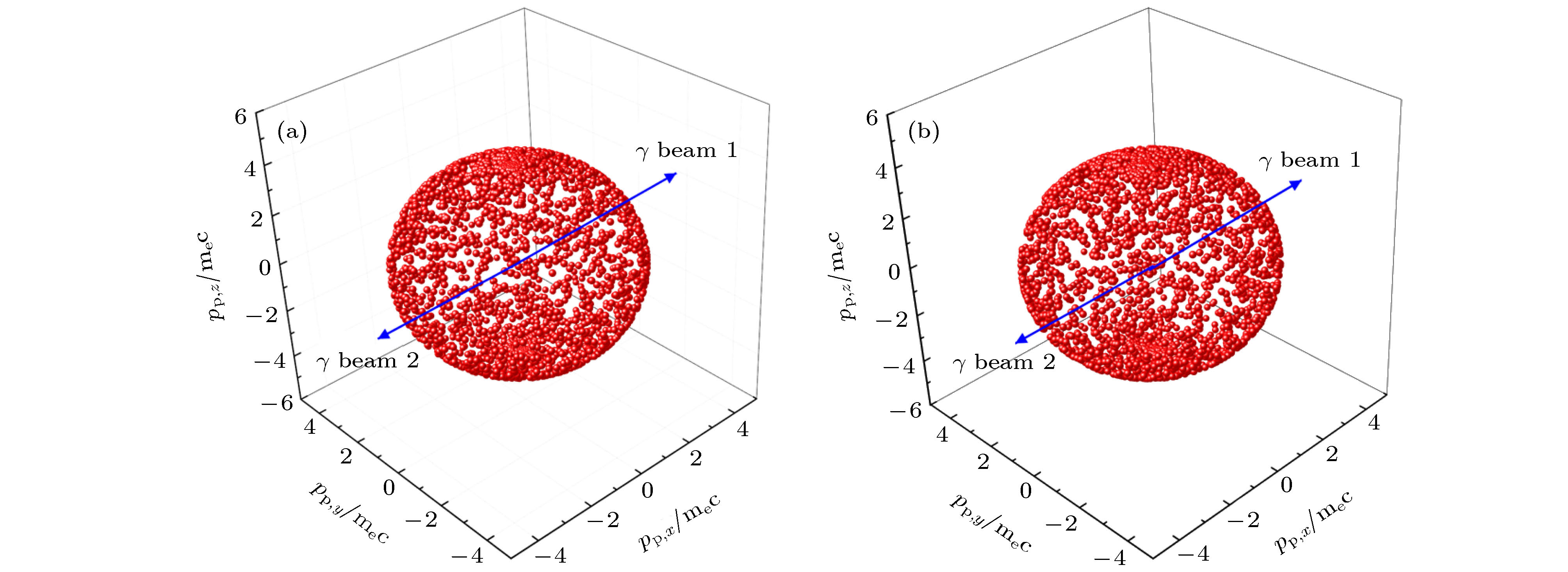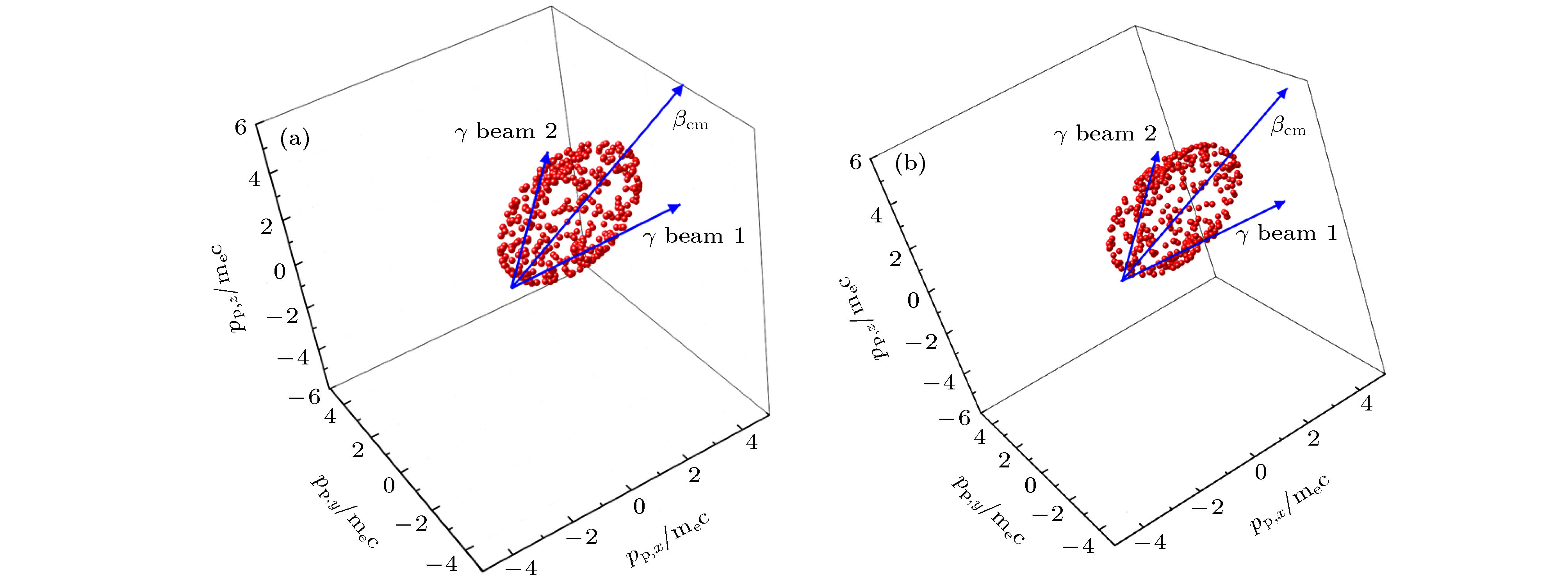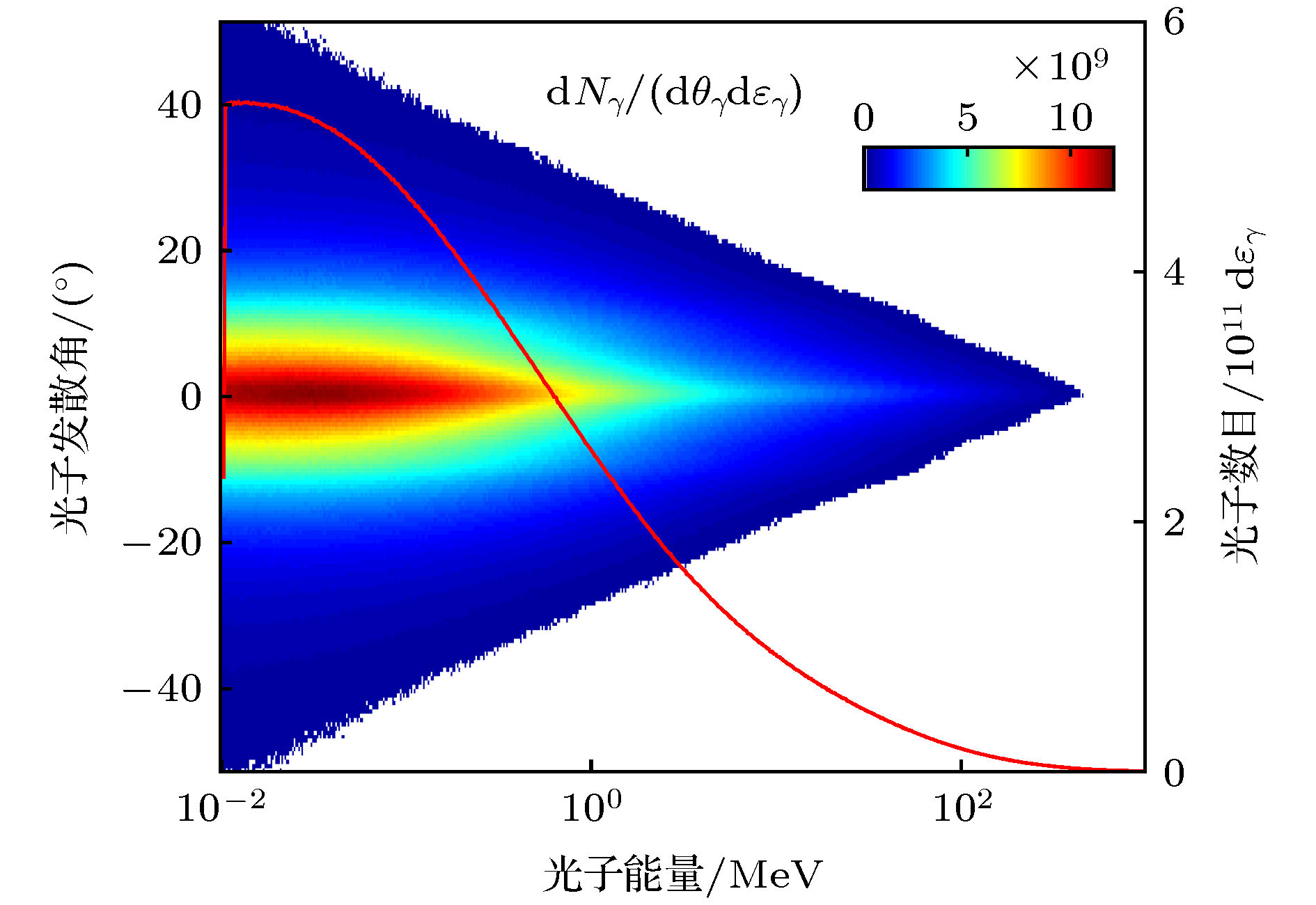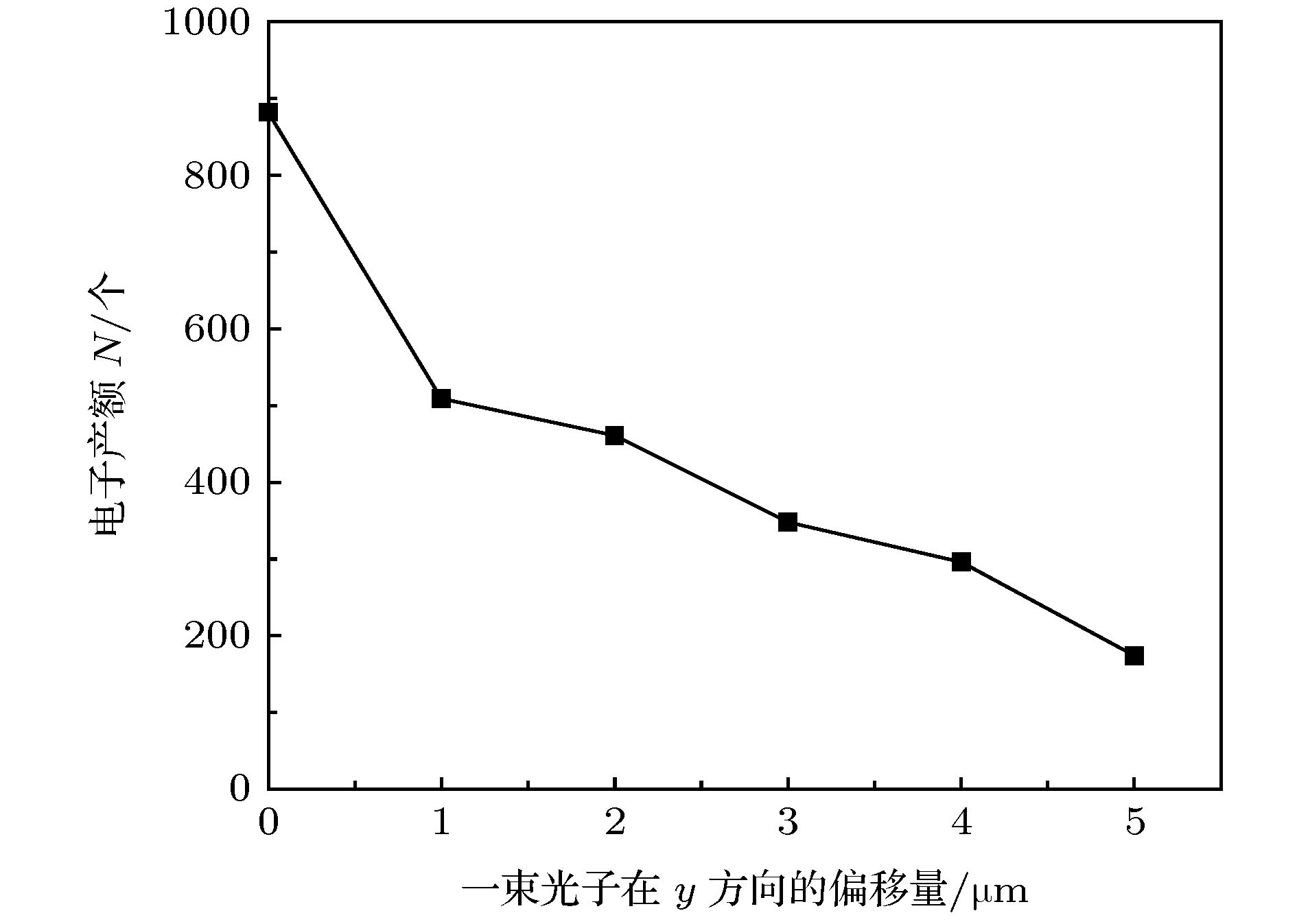-
光子对撞产生正负电子对的Breit-Wheeler过程, 是由能量直接产生物质的过程, 在物质的起源与光子物理理论的研究中有着极为重要的作用. 随着激光与物质作用产生γ光源品质的提升, 使得在实验室首次观测双光子对撞的Breit-Wheeler过程成为可能. 针对光子对撞机的数值模拟方法, 本文提出了一种基于严格的双光子对撞动力学过程的计算电子产额与动力学参数的数值方法. 在对Breit-Wheeler过程的模拟中, 根据光子的运动规律将光子划分为定量的区块, 检测区块的对撞, 然后在区块内部以动力学原理检测光子是否发生对撞, 该方法可以有效提升计算模拟的效率. 同时, 该方法与已经发表的理论结果进行了比较, 发现该计算结果与理论结果高度一致. 应用这一数值方法, 能够为Breit-Wheeler过程给出较为精确的模拟结果, 也可以为未来γγ对撞机的实验设计提供参照.
-
关键词:
- 光子对撞机 /
- 正负电子 /
- Breit-Wheeler过程 /
- 能量阈值
The creation of positron and electron pairs through photon-photon collision, named Breit-Wheeler process, has been well understood in the theories of quantum electrodynamics for nearly 100 years. The photon-photon collision, which is one of the most basic processes of matter generation in the universe, has not been observed yet. The study on photon-photon collision can promote the development of two-photon physics, quantum electrodynamics theories and high energy physics. To observe photon-photon collision in the laboratory, one needs to collimate a huge number of energetic γ-ray photons into a very small spot. Recently, the development of highly collomated source generated by 10 PW laser makes photon-photon collider much more possible than before. In photon-photon collider, the study of numerical simulation plays a critical role since no experiment has achieved such a process. In this paper, a new numerical method is developed to handle the two-photon Breit-Wheeler process. This method is based on the exact two-photon collision dynamic principle, including energy threshold condition, cross-section condition, Lorentz transformation, etc. In the method, the photons are divided into quantitative photon blocks based on the spatial coordinates. Firstly, one needs to find the collision blocks according to the spatial motion law. Secondly, the ergodic method is used to look up the photons that satisfy the energy threshold condition and the cross-section condition from the blocks. Then, one can calculate the electron yield of the photon collision, and the kinetic parameters of the positrons and electrons. This method rigorously follows the physical principle so it has high precision. On the other hand, this method determines the collision of the block in advance, which can reduce the computational requirement a lot. A series of tests is carried out to confirm the accuracy and feasibility of this numerical method by calculating the collision between mono-energetic photon beams. In the tests, the collision angle is assumed to 180° and 60° separately, the results of pair momentum distribution are discussed. We also simulate the collision of the γ-ray beams generated through the interaction between ultra-intense laser and narrow tube targets. In the simulations, the collision angle is changed from 170° to 30° to see its effect on pair production. It is found that the yield of electron-positron pairs decreases with collision angle increasing, which has also been reported in previous work. Therefore, this numerical method can be efficiently used for modeling photon-photon collider, and provide theoretical reference and suggestion to the future experimental design of γ-ray collision.-
Keywords:
- photon collider /
- electron-positron pairs /
- Breit-Wheeler process /
- threshold energy
[1] Marklund M, Shukla P K 2006 Rev. Mod. Phys. 78 591
 Google Scholar
Google Scholar
[2] Ehlotzky F, Krajewska K, Kamiński J 2009 Rep. Prog. Phys. 72 046401
 Google Scholar
Google Scholar
[3] Piazza A D, Müller C, Hatsagortsyan K Z, Keitel C H 2012 Rev. Mod. Phys. 84 1177
 Google Scholar
Google Scholar
[4] 黄金书, 罗鹏晖, 鲁公儒 2009 58 12
Huang J S, Luo P H, Lu G R 2009 Acta Phys. Sin. 58 12
[5] Burke D L, Field R C, Smith G H, Spencer J E, Walz D 1997 Phys. Rev. Lett. 79 1626
 Google Scholar
Google Scholar
[6] Breit G, Wheeler J A 1934 Phys. Rev. 46 1087
 Google Scholar
Google Scholar
[7] Yu J Q, Lu H Y, Takahashi T, Hu R H, Gong Z, Ma W J, Huang Y S, Chen C E, Yan X Q 2019 Phys. Rev. Lett. 122 014802
 Google Scholar
Google Scholar
[8] 周美林, 颜学庆 2015 物理 44 281
 Google Scholar
Google Scholar
Zhou M L, Yan X Q 2015 Physics 44 281
 Google Scholar
Google Scholar
[9] Brady C S, Ridgers C, Arber T, Bell A R 2013 Plasma. Phys. Controlled Fusion 55 124016
 Google Scholar
Google Scholar
[10] Yu J Q, Hu R H, Gong Z, Ting A, Najmudin Z, Wu D, Lu H Y, Ma W J, Yan X Q 2018 Appl. Phys. Lett. 112 204103
 Google Scholar
Google Scholar
[11] Yu T P, Pukhov A, Sheng Z M, Liu F, Shvets G 2013 Phys. Rev. Lett. 110 045001
 Google Scholar
Google Scholar
[12] Stark D J, Toncian T, Arefiev A V 2016 Phys. Rev. Lett. 116 185003
 Google Scholar
Google Scholar
[13] Capdessus R, Humi`eres E, Tikhonchuk V T 2013 Phys. Rev. Lett. 110 215003
 Google Scholar
Google Scholar
[14] Brady C S, Ridgers C P, Arber T D, Bell A R, Kirk J G 2012 Phys. Rev. Lett. 109 245006
 Google Scholar
Google Scholar
[15] Nakamura T, Koga J K, Esirkepov T Z, Kando M, Korn G, Bulanov S V 2012 Phys. Rev. Lett. 108 195001
 Google Scholar
Google Scholar
[16] Yi L, Pukhov A, Thanh P L, Shen B 2016 Phys. Rev. Lett. 116 115001
 Google Scholar
Google Scholar
[17] Ji L L, Snyder J, Pukhov A, Freeman R R, Akli K U 2016 Sci. Rep. 6 23256
 Google Scholar
Google Scholar
[18] Zhu X L, Yu T P, Sheng Z M, Yin Y, Turcu I C E, Pukhov A 2016 Nat. Commun. 7 13686
 Google Scholar
Google Scholar
[19] Liu J X, Ma Y Y, Yu T P, Zhao J, Yang X H, Zou D B, Zhang G B, Zhao Y, Yang J K, Li H Z, Zhuo H B, Shao F Q, Kawata S 2017 Chin. Phys. B 26 035202
 Google Scholar
Google Scholar
[20] Geng P F, Lv W J, Li X L, Tang R A, Xue J K 2018 Chin. Phys. B 27 035201
 Google Scholar
Google Scholar
[21] Zhang G B, Hafz N A M, Ma Y Y, Qian L J, Shao F Q, Sheng Z M 2016 Chin. Phys. Lett. 33 095202
 Google Scholar
Google Scholar
[22] Zhu X L, Yin Y, Yu T P, Shao F Q, Ge Z Y, Wang W Q, Liu J J 2015 New J. Phys. 17 053039
 Google Scholar
Google Scholar
[23] Liu J J, Yu T P, Yin Y, Zhu X L, Shao F Q 2016 Opt. Express 24 14
[24] Yu T P, Hu L X, Yin Y, Shao F Q, Zhuo H B, Ma Y Y, Yang X H, Luo W, Pukhov A 2014 Appl. Phys. Lett. 105 114101
 Google Scholar
Google Scholar
[25] Luo W, Zhu Y B, Zhuo H B, Ma Y Y, Song Y M, Zhu Z C, Wang X D, Li X H, Turcu I, Chen M 2015 Phys. Plasmas 22 063112
 Google Scholar
Google Scholar
[26] Luo W, Wu S D, Liu W Y, Ma Y Y, Li F Y, Yuan T, Yu J Y, Chen M, Sheng Z M 2018 Plasma Phys. Controlled Fusion 60 095006
 Google Scholar
Google Scholar
[27] Chen L M, Yan W C, Li D Z, Hu Z D, Zhang L, Wang W M, Hafz N, Mao J Y, Huang K, Ma Y, Zhao J R, Ma J L, Li Y T, Lu X, Sheng Z M, Wei Z Y, Gao J, Zhang J 2013 Sci. Rep. 3 1912
 Google Scholar
Google Scholar
[28] Wang W M, Sheng Z M, Gibbon P, Chen L M, Li Y T, Zhang J 2018 Proc. Natl. Acad. Sci. U.S.A. 115 9911
 Google Scholar
Google Scholar
[29] Wang W M, Gibbon P, Sheng Z M, Li Y T, Zhang J 2017 Phys. Rev. E 96 013201
 Google Scholar
Google Scholar
[30] Chen M, Luo J, Li F Y, Liu F, Sheng Z M, Zhang J 2016 Light-Sci. Appl. 5 e16015
 Google Scholar
Google Scholar
[31] Liu J B, Yu J Q, Shou Y R, Wang D H, Hu R H, Tang Y H, Wang P J, Cao Z X, Mei Z S, Lin C, Lu H Y, Zhao Y Y, Zhu K, Yan X Q, Ma W J 2019 Phys. Plasmas 26 033109
 Google Scholar
Google Scholar
[32] Gong Z, Hu R H, Lu H Y, Yu J Q, Wang D H, Fu E G, Chen C E, He X T, Yan X Q 2018 Plasma Phys. Controlled Fusion 60 044004
 Google Scholar
Google Scholar
[33] H X Chang, B Qiao, Y X Zhang, Z Xu, W P Yao, C T Zhou, X T He 2017 Phys. Plasmas 24 043111
 Google Scholar
Google Scholar
[34] Cristoforetti G, Londrillo P, Singh P K et al. 2017 Phys. Plasmas 7 1479
 Google Scholar
Google Scholar
[35] Huang T, Zhou C, Zhang H, Wu S, Qiao B, He X, Ruan S 2017 Appl. Phys. Lett. 110 021102
 Google Scholar
Google Scholar
[36] Shen B, Bu Z, Xu J, Xu T, Ji L, Li R, Xu Z 2018 Plasma Phys. Controlled Fuison 60 044002
 Google Scholar
Google Scholar
[37] Ribeyre X, d’Humi`eres E, Jansen O, Jequier S, Tikhonchuk V T, Lobet M 2016 Phys. Rev. E 93 013201
 Google Scholar
Google Scholar
[38] Jansen O, d’Humi`eres E, Ribeyre X, Jequier S, Tikhonchuk V T 2018 J. Comput. Phys. 355 582
[39] Pike O J, Mackenroth F, Hill E G, Rose S J 2014 Nat. Photonics 8 434
 Google Scholar
Google Scholar
[40] Ribeyre X, d’Humi`eres E, Jansen O, Jequier S, Tikhonchuk V T 2017 Plasma Phys. Controlled Fusion 59 014024
 Google Scholar
Google Scholar
-
-
[1] Marklund M, Shukla P K 2006 Rev. Mod. Phys. 78 591
 Google Scholar
Google Scholar
[2] Ehlotzky F, Krajewska K, Kamiński J 2009 Rep. Prog. Phys. 72 046401
 Google Scholar
Google Scholar
[3] Piazza A D, Müller C, Hatsagortsyan K Z, Keitel C H 2012 Rev. Mod. Phys. 84 1177
 Google Scholar
Google Scholar
[4] 黄金书, 罗鹏晖, 鲁公儒 2009 58 12
Huang J S, Luo P H, Lu G R 2009 Acta Phys. Sin. 58 12
[5] Burke D L, Field R C, Smith G H, Spencer J E, Walz D 1997 Phys. Rev. Lett. 79 1626
 Google Scholar
Google Scholar
[6] Breit G, Wheeler J A 1934 Phys. Rev. 46 1087
 Google Scholar
Google Scholar
[7] Yu J Q, Lu H Y, Takahashi T, Hu R H, Gong Z, Ma W J, Huang Y S, Chen C E, Yan X Q 2019 Phys. Rev. Lett. 122 014802
 Google Scholar
Google Scholar
[8] 周美林, 颜学庆 2015 物理 44 281
 Google Scholar
Google Scholar
Zhou M L, Yan X Q 2015 Physics 44 281
 Google Scholar
Google Scholar
[9] Brady C S, Ridgers C, Arber T, Bell A R 2013 Plasma. Phys. Controlled Fusion 55 124016
 Google Scholar
Google Scholar
[10] Yu J Q, Hu R H, Gong Z, Ting A, Najmudin Z, Wu D, Lu H Y, Ma W J, Yan X Q 2018 Appl. Phys. Lett. 112 204103
 Google Scholar
Google Scholar
[11] Yu T P, Pukhov A, Sheng Z M, Liu F, Shvets G 2013 Phys. Rev. Lett. 110 045001
 Google Scholar
Google Scholar
[12] Stark D J, Toncian T, Arefiev A V 2016 Phys. Rev. Lett. 116 185003
 Google Scholar
Google Scholar
[13] Capdessus R, Humi`eres E, Tikhonchuk V T 2013 Phys. Rev. Lett. 110 215003
 Google Scholar
Google Scholar
[14] Brady C S, Ridgers C P, Arber T D, Bell A R, Kirk J G 2012 Phys. Rev. Lett. 109 245006
 Google Scholar
Google Scholar
[15] Nakamura T, Koga J K, Esirkepov T Z, Kando M, Korn G, Bulanov S V 2012 Phys. Rev. Lett. 108 195001
 Google Scholar
Google Scholar
[16] Yi L, Pukhov A, Thanh P L, Shen B 2016 Phys. Rev. Lett. 116 115001
 Google Scholar
Google Scholar
[17] Ji L L, Snyder J, Pukhov A, Freeman R R, Akli K U 2016 Sci. Rep. 6 23256
 Google Scholar
Google Scholar
[18] Zhu X L, Yu T P, Sheng Z M, Yin Y, Turcu I C E, Pukhov A 2016 Nat. Commun. 7 13686
 Google Scholar
Google Scholar
[19] Liu J X, Ma Y Y, Yu T P, Zhao J, Yang X H, Zou D B, Zhang G B, Zhao Y, Yang J K, Li H Z, Zhuo H B, Shao F Q, Kawata S 2017 Chin. Phys. B 26 035202
 Google Scholar
Google Scholar
[20] Geng P F, Lv W J, Li X L, Tang R A, Xue J K 2018 Chin. Phys. B 27 035201
 Google Scholar
Google Scholar
[21] Zhang G B, Hafz N A M, Ma Y Y, Qian L J, Shao F Q, Sheng Z M 2016 Chin. Phys. Lett. 33 095202
 Google Scholar
Google Scholar
[22] Zhu X L, Yin Y, Yu T P, Shao F Q, Ge Z Y, Wang W Q, Liu J J 2015 New J. Phys. 17 053039
 Google Scholar
Google Scholar
[23] Liu J J, Yu T P, Yin Y, Zhu X L, Shao F Q 2016 Opt. Express 24 14
[24] Yu T P, Hu L X, Yin Y, Shao F Q, Zhuo H B, Ma Y Y, Yang X H, Luo W, Pukhov A 2014 Appl. Phys. Lett. 105 114101
 Google Scholar
Google Scholar
[25] Luo W, Zhu Y B, Zhuo H B, Ma Y Y, Song Y M, Zhu Z C, Wang X D, Li X H, Turcu I, Chen M 2015 Phys. Plasmas 22 063112
 Google Scholar
Google Scholar
[26] Luo W, Wu S D, Liu W Y, Ma Y Y, Li F Y, Yuan T, Yu J Y, Chen M, Sheng Z M 2018 Plasma Phys. Controlled Fusion 60 095006
 Google Scholar
Google Scholar
[27] Chen L M, Yan W C, Li D Z, Hu Z D, Zhang L, Wang W M, Hafz N, Mao J Y, Huang K, Ma Y, Zhao J R, Ma J L, Li Y T, Lu X, Sheng Z M, Wei Z Y, Gao J, Zhang J 2013 Sci. Rep. 3 1912
 Google Scholar
Google Scholar
[28] Wang W M, Sheng Z M, Gibbon P, Chen L M, Li Y T, Zhang J 2018 Proc. Natl. Acad. Sci. U.S.A. 115 9911
 Google Scholar
Google Scholar
[29] Wang W M, Gibbon P, Sheng Z M, Li Y T, Zhang J 2017 Phys. Rev. E 96 013201
 Google Scholar
Google Scholar
[30] Chen M, Luo J, Li F Y, Liu F, Sheng Z M, Zhang J 2016 Light-Sci. Appl. 5 e16015
 Google Scholar
Google Scholar
[31] Liu J B, Yu J Q, Shou Y R, Wang D H, Hu R H, Tang Y H, Wang P J, Cao Z X, Mei Z S, Lin C, Lu H Y, Zhao Y Y, Zhu K, Yan X Q, Ma W J 2019 Phys. Plasmas 26 033109
 Google Scholar
Google Scholar
[32] Gong Z, Hu R H, Lu H Y, Yu J Q, Wang D H, Fu E G, Chen C E, He X T, Yan X Q 2018 Plasma Phys. Controlled Fusion 60 044004
 Google Scholar
Google Scholar
[33] H X Chang, B Qiao, Y X Zhang, Z Xu, W P Yao, C T Zhou, X T He 2017 Phys. Plasmas 24 043111
 Google Scholar
Google Scholar
[34] Cristoforetti G, Londrillo P, Singh P K et al. 2017 Phys. Plasmas 7 1479
 Google Scholar
Google Scholar
[35] Huang T, Zhou C, Zhang H, Wu S, Qiao B, He X, Ruan S 2017 Appl. Phys. Lett. 110 021102
 Google Scholar
Google Scholar
[36] Shen B, Bu Z, Xu J, Xu T, Ji L, Li R, Xu Z 2018 Plasma Phys. Controlled Fuison 60 044002
 Google Scholar
Google Scholar
[37] Ribeyre X, d’Humi`eres E, Jansen O, Jequier S, Tikhonchuk V T, Lobet M 2016 Phys. Rev. E 93 013201
 Google Scholar
Google Scholar
[38] Jansen O, d’Humi`eres E, Ribeyre X, Jequier S, Tikhonchuk V T 2018 J. Comput. Phys. 355 582
[39] Pike O J, Mackenroth F, Hill E G, Rose S J 2014 Nat. Photonics 8 434
 Google Scholar
Google Scholar
[40] Ribeyre X, d’Humi`eres E, Jansen O, Jequier S, Tikhonchuk V T 2017 Plasma Phys. Controlled Fusion 59 014024
 Google Scholar
Google Scholar
计量
- 文章访问数: 10834
- PDF下载量: 170
- 被引次数: 0














 下载:
下载:





